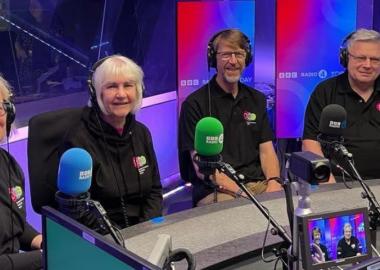There’s a wonderful variety of musical genres being played and sung in towns, cities and neighbourhoods across the UK, so we decided to create introductory guides to some of them. Pick a genre and dive in to find out more and how you can get involved. Or if you would like to submit an introduction to your favourite kind of music, please email us
Barbershop
It’s not all about striped coats and funny hats! The Barbershop movement was born in 1938 in Tulsa, Oklahoma, to revive and preserve a style of music that was linked to barber shops (which, more than grooming salons, were basically places for men to hang out) in America.
Brass bands
Just as important as the group of instruments that makes up a brass band is the tradition that surrounds them; a tradition of (mostly) friendly rivalries, contesting, local pride, and community. Brass banding is a social pastime as much as a musical one.
Community choirs
A community choir is a singing group that welcomes everyone - whether you’re a seasoned singer or a complete beginner. These choirs are open, inclusive spaces where people from all walks of life can enjoy singing in a group setting.
Early music
Early music first hit the British headlines in the late 1960s and early 1970s, with European medieval, renaissance and early baroque music being introduced to a wide audience.
Folk music
UK folk music came from ordinary people within a region or nation, where songs would have been passed down orally and music would have been learned by ear. In the late 19th century there was a movement in collection and documentation of this music, which developed throughout the 20th century into ‘folk’ as a distinct musical genre.
Handbell ringing
When people think of handbells, the image that most often comes to mind first is the kind of bell used by a town crier, or the bell that was rung in the school playground to signify that it was time to come back in for more lessons. But how is it used to make music?
Indian classical music
What is Indian classical music and how is it different to Bollywood or Indian folk music? What are all the different instruments used and where can you go to try listening to it or playing it yourself? Seetal Kaur of member group, the Sitar Music Society, gives us an overview.
Pipe and tabor
These are two instruments played simultaneously by one musician. This is possible because the pipe only has three finger holes, so can be played with one hand while the other hand beats the rhythm on a tabor. A tabor is a drum with two skins which is played with one hand, and usually has a snare on the batterhead.
Samba
What makes this music from Brazil so popular? How do you successfully navigate amongst the dozens of music styles? It’s a music genre that developed in Brazil in the early 1900s amongst extremely poor workers that fled to Rio and Bahia. Except for some limited European and indigenous American ingrendients, Samba is mostly an evolution of the music of African slaves.
Signing choirs
In the UK, choirs that use British Sign Language (BSL) to perform musical repertoire are known as signing choirs. Signing choirs were first developed in the church, in partnership with the Deaf members of the congregation, to encourage equality between the experience of Deaf and hearing members in services.
Wind bands
What's included in the 'wind' bit? Why has the repertoire grown so much in the last century? And what do they offer musicians that orchestral music often doesn't? Some people think that the word ‘wind’ means just woodwind instruments, but in this case the word ‘wind’ refers to the way the sound is produced, rather than being a short version of the word ‘woodwind’.
We hope you find this Making Music resource useful. If you have any comments or suggestions about the guidance please contact us. Whilst every effort is made to ensure that the content of this guidance is accurate and up to date, Making Music do not warrant, nor accept any liability or responsibility for the completeness or accuracy of the content, or for any loss which may arise from reliance on the information contained in it.










